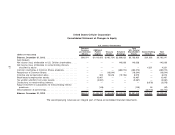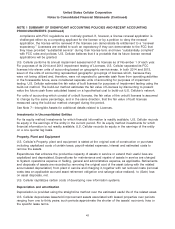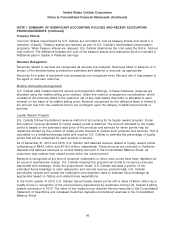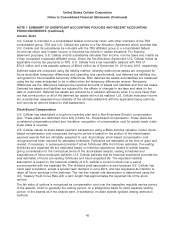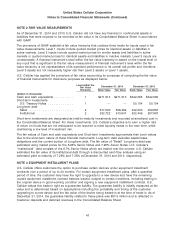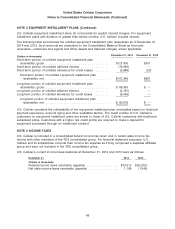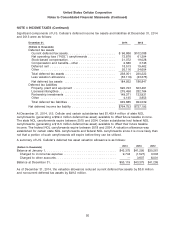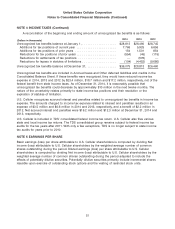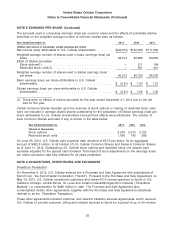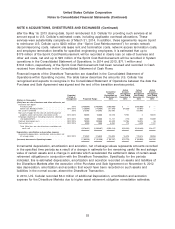US Cellular 2014 Annual Report Download - page 55
Download and view the complete annual report
Please find page 55 of the 2014 US Cellular annual report below. You can navigate through the pages in the report by either clicking on the pages listed below, or by using the keyword search tool below to find specific information within the annual report.
United States Cellular Corporation
Notes to Consolidated Financial Statements (Continued)
NOTE 2 FAIR VALUE MEASUREMENTS
As of December 31, 2014 and 2013, U.S. Cellular did not have any financial or nonfinancial assets or
liabilities that were required to be recorded at fair value in its Consolidated Balance Sheet in accordance
with GAAP.
The provisions of GAAP establish a fair value hierarchy that contains three levels for inputs used in fair
value measurements. Level 1 inputs include quoted market prices for identical assets or liabilities in
active markets. Level 2 inputs include quoted market prices for similar assets and liabilities in active
markets or quoted market prices for identical assets and liabilities in inactive markets. Level 3 inputs are
unobservable. A financial instrument’s level within the fair value hierarchy is based on the lowest level of
any input that is significant to the fair value measurement. A financial instrument’s level within the fair
value hierarchy is not representative of its expected performance or its overall risk profile and, therefore,
Level 3 assets are not necessarily higher risk than Level 2 assets or Level 1 assets.
U.S. Cellular has applied the provisions of fair value accounting for purposes of computing the fair value
of financial instruments for disclosure purposes as displayed below.
Level within the December 31, 2014 December 31, 2013
Fair Value
Hierarchy Book Value Fair Value Book Value Fair Value
(Dollars in thousands)
Cash and cash equivalents ........... 1 $211,513 $211,513 $342,065 $342,065
Short-term investments
U.S. Treasury Notes .............. 1 — — 50,104 50,104
Long-term debt
Retail ......................... 2 617,000 608,462 342,000 309,852
Institutional ..................... 2 532,722 513,647 532,449 507,697
Short-term investments are designated as held-to-maturity investments and recorded at amortized cost in
the Consolidated Balance Sheet. For these investments, U.S. Cellular’s objective is to earn a higher rate
of return on funds that are not anticipated to be required to meet liquidity needs in the near term, while
maintaining a low level of investment risk.
The fair values of Cash and cash equivalents and Short-term investments approximate their book values
due to the short-term nature of these financial instruments. Long-term debt excludes capital lease
obligations and the current portion of Long-term debt. The fair value of ‘‘Retail’’ Long-term debt was
estimated using market prices for the 6.95% Senior Notes and 7.25% Senior Notes. U.S. Cellular’s
‘‘Institutional’’ debt consists of the 6.7% Senior Notes which are traded over the counter. U.S. Cellular
estimated the fair value of its Institutional debt through a discounted cash flow analysis using an
estimated yield to maturity of 7.25% and 7.35% at December 31, 2014 and 2013, respectively.
NOTE 3 EQUIPMENT INSTALLMENT PLANS
U.S. Cellular offers customers the option to purchase certain devices under equipment installment
contracts over a period of up to 24 months. For certain equipment installment plans, after a specified
period of time, the customer may have the right to upgrade to a new device and have the remaining
unpaid equipment installment contract balance waived, subject to certain conditions, including trading in
the original device in good working condition and signing a new equipment installment contract. U.S.
Cellular values this trade-in right as a guarantee liability. The guarantee liability is initially measured at fair
value and is determined based on assumptions including the probability and timing of the customer
upgrading to a new device and the fair value of the device being traded-in at the time of trade-in. As of
December 31, 2014, the guarantee liability related to these plans was $57.5 million and is reflected in
Customer deposits and deferred revenues in the Consolidated Balance Sheet.
47


